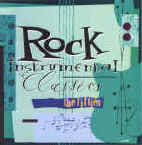
By mid-1959, a new fad had over taken rock and roll hot guitar and saxophone instrumentals.

By mid-1959, a new fad had over taken rock and roll hot
guitar and saxophone instrumentals.
The first rock and roll instrumental was Bill Doggett's "Honkey Tonk in late 1956. More than a year later the second big instrumental was Bill Justis' "Raunchy." By mid-1958, the Champs and Duane Eddy each were beginning a long string of instrumental hits.
Riding the their coat tails came dozens of artist and combos, most with only one minor hit. Among the more successful were the Applejacks ("Mexican Hat Rock",) Link Wray ("Rumble"), the Royaltones ("Poor Boy'), the Gone All-Stars ("7-11"), Lee Allen ("Walking With Mr. Lee"), Dave "Baby" Cortez ("The Happy Organ"), the Kingsmen ("Weekend"), Ernie Fields ("In The Mood"), Sandy Nelson ("Teen Beat"), the Virtues ("Guitar Boogie Shuffle"), Preston Epps ("Bongo Rock"), the Rock-A-Teens ("Woo-Hoo"), the Wailers ("Tall Cool One"), the Fireballs (Torquay"), Chet Atkins ("Boo Boo Stick Beat"), the Hot-Toddys ("Rockin' Crickets"), the Rockin' R's ("The Beat"), the Wildcats ("Gazachstahagen"), and the Intruders ("Fried Eggs"), the Quarter Notes ("Record Hop Blues"), and the Frantics ("Straight Flush"). Those were just the individuals and groups with hits through the end of 1959.
Originally rock instrumentals were played by R&B dance combos that flourished in the early Fifties. These bands usually featured an organist or honky-tonk pianist or sax player.
These bands remained popular at dances, but by 1957 black music had become almost purely vocal as far as recording was concerned. White rock had divided into two categories: teen idols and rockabilly. Rockabilly had little commercial appeal and by the late Fifties, white rock was almost completely monopolized by teen idols.
The result of this divergence of rock and roll from its roots, was the appearance of white instrumental bands popping up around the country, keeping the music alive at the local level and directly in- flunking the British bands that would signal the start of Rock's classic era.
Instrumental groups were generally regional, products of the local music scenes that had been the source of virtually every significant innovation in rock and roll. The professional musicians in the music capitals - New York, Los Angeles, and London - had become insulated from influences outside the music industry, while local bands, playing in front of audiences which they had a direct rapport, started new styles, dance and music developments.
In the early days bands were simply there to back up a singer. Many of the early instrumental groups continued to feature singers on some numbers, but the rockabilly style of signing was becoming dated. These these bands just wanted to rock, and played for the audiences that wanted to drink and dance. So they just did away with the singer altogether.
The earliest instrumental rock hits "Honky Tonk," " Raunchy," and "Topsy" featured saxophones, piano, and drums. Toward the end of 1958, guitar, the predominant instruments of rockabilly, began taking over instrumental rock. The tunes were usually simple, relying on a gimmick, but others created an intense mood , such as Link Wray's "Rumble" or Johnny and the Hurricanes' "Crossfire."
Link Wray was the most volatile and sophisticated guitarists to emerge from this period and would later inspire Peter Townshend and Eric Clapton.
The most successful rocker was Duane Eddy, who developed a style known as the "twangy" guitar. Eddy had nearly twenty pop hits and was one of America's biggest international stars, especially in England where instrumentals dominated the rock scene.
1959 yielded a number of instrumental hits. It seemed that every city had an instrumental band as a hometown favorite. However, it was hard to bridge the gap between what the local dancing audiences liked and what was needed for a Top Forty hit. The dance crazes began in 1960 and lasted through 1962 providing plenty of work for thousands of these bands.
The most important instrumental band was Seattle's the Ventures. Their music was smooth, polished and technically precise. Important hits were 1960's "Walk - Don't Run" and "Pefidia." Playing into the Seventies, the Ventures recorded over fifty albums and inspiring guitarists all over the world.
By 1962 instrumentals were competing with soul records, "girl group" records and dance vocals for airplay. Though relegated to the repertoire of amateur bands again, instrumental rock wasn't dead yet.
In 1963 surf music began with Dick Dale's "Let's Go Trippn'," a big L.A. hit, with the Beach Boys and Jan and Dean establishing it. California had developed a number of local instrumental bands playing Dick Dale style music for surfers in 1961 and 1962, By 1963 the Chanteys' "Pipeline," the Pyramids "Penetration," and the Surfaris' "Wipe Out' had national hits. Across the country instrumental groups switched over to surf music. But surf music was the last hurrah for instrumental rock as vocals took over white rock after the British Invasion of 1964.
![]()